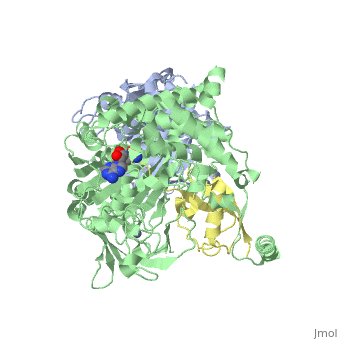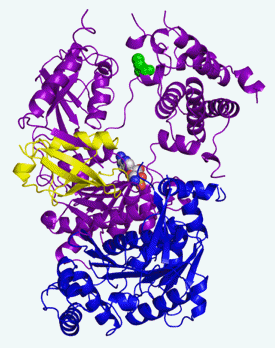Function
SUMO is a Small Ubiquitin-like MOdifier which covalently attaches to cellular proteins to modify their function. SUMO is similar in structure but not in sequence to ubiquitin. In several organisms SUMO is called SMT3. The SUMO-conjugating enzyme (E2) is called UBC9. The sentrin specific protease (SEPN) cleaves the C-terminal peptide from SUMO which then can bind to ubiquitin activating enzyme (E1). For details on SUMO-1 protein complex see
Relevance
Sumoylation may have a potential role in Alzheimer disease and decrease sumoylation of lamina A is a causative factor in familial dilated cardiomyopathy[1].
Structural highlights
Ubiquitin (Ub) and ubiquitin-like (Ubl) proteins attached to their target proteins and modulating the activities of those targets in various ways. Three types of evolutionarily conserved enzymes — E1 activating enzymes, E2 conjugating enzymes and E3 ligase enzymes — act sequentially through parallel yet distinct pathways to conjugate ubiquitin and Ubl proteins, such as SUMO and NEDD8, to their targets. The E1 enzyme uses the and magnesium to adenylate the C-terminal Ub/Ubl glycine, releasing pyrophosphate and resulting in . A non-hydrolysable and were constructed. In both these compounds the atom of phosphorus is replaced by sulfur (colored yellow).
The of the crystal structures for human SUMO E1 in complex with SUMO adenylate (AMSN) and tetrahedral intermediate (AVSN) analogues revealed opened conformation (SUMO1 in orange, SAE1 colored in blue, and other domains in darkviolet) and closed conformation (SUMO1 in yellow, SAE1 colored in cyan, and other domains in magenta), respectively. In the (3kyc) the distance between Cys domain (including Cys173) and mimic of the acyl adenylate intermediate AMSN is very long, while in the (3kyd), the catalytic Cys173 is posioned near AVSN and SUMO1, so the overall structure revealed dramatic rearrangement. This large conformational change forms the .[2]
For better understanding of the difference between these two conformations you can see this morph (generated by using POLYVIEW-3D: http://polyview.cchmc.org/polyview3d.html; reload/refresh this page to restart this movie). Of note, in contrast to the previous figure, the same domains of these two structures (3kyc and 3kyd) are colored in the same colors (SUMO1 in yellow, SAE1 colored in blue and other domains in darkviolet). The catalytic Cys173 is shown in the spacefill representation and colored green, AMSN (or AVSN) are shown in the spacefill representation and colored in CPK colors.
3D Structures of SUMO
SUMO 3D Structures


